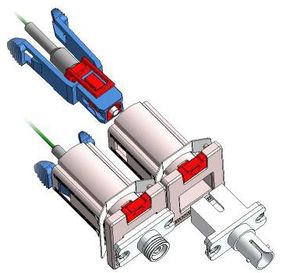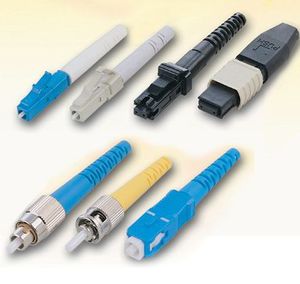Optical Fiber Connectors
Optical Fiber Connector terminates the end of an optical fiber, and enables quicker connection and disconnection than splicing. The Connectors mechanically couple and align the cores of fibers so light can pass. Better connectors lose very little light due to reflection or misalignment of the fibers.
Application
Optical fiber connectors are used to join optical fibers where a connect or disconnect capability is required. The basic connector unit is a connector assembly. A connector assembly consists of an adapter and two connector plugs. Due to the polishing and tuning procedures that may be incorporated into optical connector manufacturing, connectors are generally assembled onto optical fiber in a supplier’s manufacturing facility. However, the assembly and polishing operations involved can be performed in the field, for example, to make cross-connect jumpers to size.Optical fiber connectors are used in telephone company central offices, at installations on customer premises, and in outside plant applications to connect equipment and cables, or to cross-connect cables.
Most optical fiber connectors are spring-loaded, so the fiber faces are pressed together when the connectors are mated. The resulting glass-to-glass or plastic-to-plastic contact eliminates signal losses that would be caused by an air gap between the joined fibers.
Every fiber connection has two values:
- Attenuation or insertion loss
- Reflection or return loss.
Measurements of these parameters are now defined in IEC standard 61753-1. The standard gives five grades for insertion loss from A (best) to D (worst), and M for multimode. The other parameter is return loss, with grades from 1 (best) to 5 (worst).
A variety of optical fiber connectors are available, but SC and LC connectors are the most common types of connectors on the market.Typical connectors are rated for 500–1,000 mating cycles.The main differences among types of connectors are dimensions and methods of mechanical coupling. Generally, organizations will standardize on one kind of connector, depending on what equipment they commonly use. Different connectors are required for multimode, and for single-mode fibers.In many data center applications, small and multi-fiber connectors are replacing larger, older styles , allowing more fiber ports per unit of rack space.
Features of good connector design:
- Low insertion loss
- High return loss (low amounts of reflection at the interface)
- Ease of installation
- Low cost
- Reliability
- Low environmental sensitivity
- Ease of use
Outside plant applications may require connectors be located underground, or on outdoor walls or utility poles. In such settings, protective enclosures are often used, and fall into two broad categories: hermetic (sealed) and free-breathing. Hermetic cases prevent entry of moisture and air but, lacking ventilation, can become hot if exposed to sunlight or other sources of heat. Free-breathing enclosures, on the other hand, allow ventilation, but can also admit moisture, insects and airborne contaminants. Selection of the correct housing depends on the cable and connector type, the location, and environmental factors. Careful assembly is required to ensure good protection against the elements.
Depending on user requirements, housings for outside plant applications may be tested by the manufacturer under various environmental simulations, which could include physical shock and vibration, water spray, water immersion, dust, etc. to ensure the integrity of optical fiber connections and housing seals.
Testing
Glass fiber optic connector performance is affected both by the connector and by the glass fiber. Concentricity tolerances affect the fiber, fiber core, and connector body. The core optical index of refraction is also subject to variations. Stress in the polished fiber can cause excess return loss. The fiber can slide along its length in the connector. The shape of the connector tip may be incorrectly profiled during polishing. The connector manufacturer has little control over these factors, so in-service performance may well be below the manufacturer's specification.
Testing fiber optic connector assemblies falls into two general categories: factory testing and field testing.Factory testing is sometimes statistical, for example, a process check. A profiling system may be used to ensure the overall polished shape is correct, and a good quality optical microscope to check for blemishes. Optical Loss / Return Loss performance is checked using specific reference conditions, against a reference-standard single mode test lead, or using an Encircled Flux Compliant source for multi-mode testing. Testing and rejection may represent a significant part of the overall manufacturing cost. Field testing is usually simpler. A special hand-held optical microscope is used to check for dirt or blemishes, and an optical time-domain reflectometer may be used to identify significant point losses or return losses. A power meter and light source or loss test set may also be used to check end-to-end loss.

